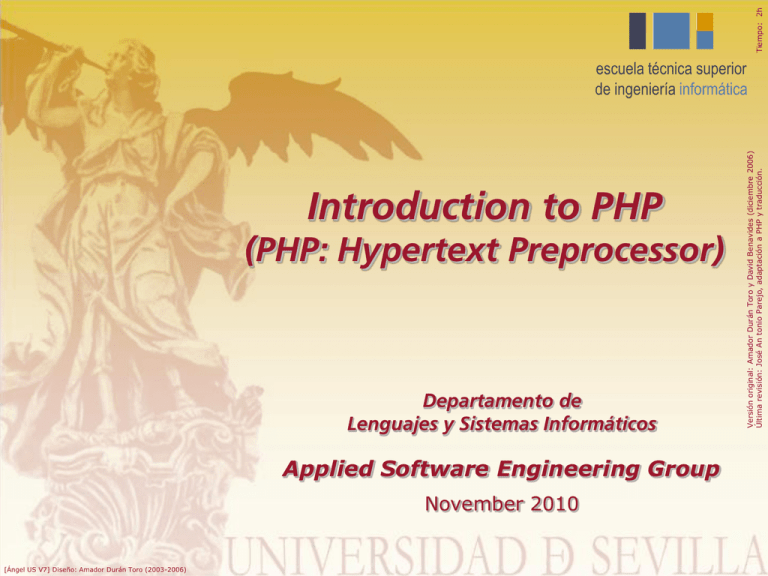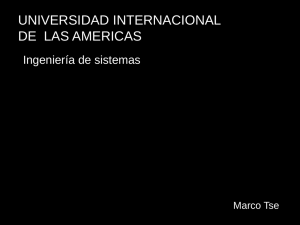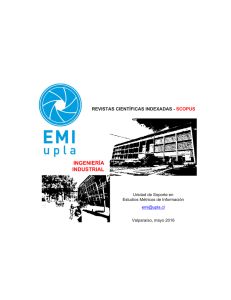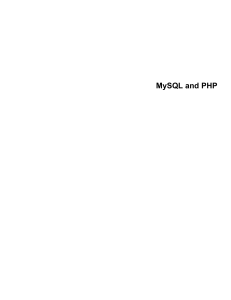Introduction to PHP - Departamento de Lenguajes y Sistemas
Anuncio

Tiempo: 2h Introduction to PHP (PHP: Hypertext Preprocessor) Departamento de Lenguajes y Sistemas Informáticos Applied Software Engineering Group November 2010 [Ángel US V7] Diseño: Amador Durán Toro (2003-2006) Versión original: Amador Durán Toro y David Benavides (diciembre 2006) Última revisión: José An tonio Parejo, adaptación a PHP y traducción. escuela técnica superior de ingeniería informática [Ángel US V7] Diseño: Amador Durán Toro (2003-2006) Introduction to PHP • Server Processing Escuela Técnica Superior de Ingeniería Informática Departamento de Lenguajes y Sistemas Informáticos PHP 1. Introduction PDO 2. The PHP Language 1. Comments 2. Types 5. Control flow structures 6. Classes and objects 7. Predefined classes 3. PHP programming styles Web client 8 2 7 4 3 Data 1 Business Logic 4. Functions Presentation 3. Variables 6 DBMS 5 Web server (with processing capabilities) Sevilla, noviembre de 2010 Grupo de Ingeniería del 1 [Ángel US V7] Diseño: Amador Durán Toro (2003-2006) Introduction to PHP • Basic Concepts Escuela Técnica Superior de Ingeniería Informática Departamento de Lenguajes y Sistemas Informáticos 1. Introduction 2. The PHP Language 1. Comments 2. Types 3. Variables 4. Functions 5. Control flow structures 6. Classes and objects 7. Predefined classes 3. PHP programming styles – PHP = Personal Home Page PHP: Hipertext Preprocessor – PHP is a language that allows creating scripts that are interpeted at server, creating content that is sent to the client. – PHP is neither standard nor has a formal specification, but is a widely accepted Open Source technology. – The pages must have the extension .php, otherwise the server does not process the PHP code – A PHP page can not be properly opened as file. It must be done by means of a web server (usually Apache), usually as: • http://localhost/…/archivo.php • http://127.0.0.1/…/archivo.php • http://nombre_máquina/…/archivo.php • http://dirección IP/…/archivo.php Sevilla, noviembre de 2010 Grupo de Ingeniería del 2 [Ángel US V7] Diseño: Amador Durán Toro (2003-2006) Introduction to PHP • Un poco de Historia de PHP: Año Escuela Técnica Superior de Ingeniería Informática Departamento de Lenguajes y Sistemas Informáticos 1. Introduction Versión 1995 PHP 1.0 Set of simple scripts written in Perl by Rasmus Lerdorf. Latter it were rewritten in C providing DB access capabilities. 1997 PHP 2.0 Set of scripts in beta state . 1998 PHP 3.0 2000 PHP 4.0 Performance improvements, modularity more DB Support and third party. 2004 PHP 5.0 New object model, performance improvements ? PHP 6.0 Unicode support, namespaces, closures (this 2 last features were present in v5.3) 2. The PHP Language 1. Comments 2. Types 3. Variables 4. Functions 5. Control flow structures 6. Classes and objects 3. PHP programming styles Sevilla, noviembre de 2010 Grupo de Ingeniería del Time 7. Predefined classes Características It was the first version similar to current PHP, full rewrite by Andi Gutmans and Zeev Suraski. It included a stronger syntax and mimimal OO support. 3 [Ángel US V7] Diseño: Amador Durán Toro (2003-2006) Introduction to PHP • Usage of PHP: Escuela Técnica Superior de Ingeniería Informática Departamento de Lenguajes y Sistemas Informáticos 1. Introduction 2. The PHP Language 1. Comments 2. Types 3. Variables 4. Functions 5. Control flow structures 6. Classes and objects 7. Predefined classes 3. PHP programming styles http://www.tiobe.com/index.php/content/paperinfo/tpci/index.html Sevilla, noviembre de 2010 Grupo de Ingeniería del 4 [Ángel US V7] Diseño: Amador Durán Toro (2003-2006) Introduction to PHP • PHP Objects Escuela Técnica Superior de Ingeniería Informática Departamento de Lenguajes y Sistemas Informáticos 1. Introduction 2. The PHP Language 1. Comments 2. Types 3. Variables 4. Functions 5. Control flow structures 6. Classes and objects 7. Predefined classes 3. PHP programming styles – Predefined classes, variables and functions of PHP and data access objects (PDO) are the elements of the language that we will use most frequently. – Predefined PHP variables are always available in PHP code, namely: $GLOBALS, $_SESSION, $_REQUEST,$_GET, $_POST, $_FILES, $_COOKIE, $_SERVER, $_ENV. – PHP incorporates a garbage collector, so we must not destroy objects explicitly. However we must create destructors if we use blocking resources, such as DB connections, printers or files. • PDO Objects – PDO objects must be created explicitly (as all ordinary PHP objects) using new. – We will use PHP pages to process data form sent forms, access a database and returns a response to user. Sevilla, noviembre de 2010 Grupo de Ingeniería del 5 [Ángel US V7] Diseño: Amador Durán Toro (2003-2006) Introduction to PHP • Structure of an PHP page Escuela Técnica Superior de Ingeniería Informática Departamento de Lenguajes y Sistemas Informáticos 1. Introduction 2. The PHP Language 1. Comments 2. Types 3. Variables 4. Functions 5. Control flow structures 6. Classes and objects 7. Predefined classes 3. PHP programming styles <html> <!– HTML code --> … <?php PHP code ?> … <!– HTML code --> … <script language=“php” %> PHP code </script> … <!– HTML code --> </html> • Moreover we can use : <? … ?> <% … %> Sevilla, noviembre de 2006 Grupo de Ingeniería del 6 [Ángel US V7] Diseño: Amador Durán Toro (2003-2006) Introduction to PHP • Main features of PHP: Escuela Técnica Superior de Ingeniería Informática Departamento de Lenguajes y Sistemas Informáticos 1. Introduction 2. The PHP Language – Is an interpreted languge (script, not compiled) – Is an Object based language – Syntax similar to C and Java 1. Comments 2. Types 3. Variables 4. Functions 5. Control flow structures 6. Classes and objects 7. Predefined classes 3. PHP programming styles Sevilla, noviembre de 2010 Grupo de Ingeniería del 7 [Ángel US V7] Diseño: Amador Durán Toro (2003-2006) Introduction to PHP • Comments: Escuela Técnica Superior de Ingeniería Informática Departamento de Lenguajes y Sistemas Informáticos 1. Introduction 2. The PHP Language 1. Comments // C-stlye Comment # Shell-style Comment /* Multi-line Java-style comment */ 2. Types 3. Variables 4. Functions 5. Control flow structures 6. Classes and objects 7. Predefined classes 3. PHP programming styles Sevilla, noviembre de 2010 Grupo de Ingeniería del 8 [Ángel US V7] Diseño: Amador Durán Toro (2003-2006) Introduction to PHP • PHP is weakly typed language Escuela Técnica Superior de Ingeniería Informática Departamento de Lenguajes y Sistemas Informáticos 1. Introduction 2. The PHP Language 1. Comments 2. Types 3. Variables 4. Functions 5. Control flow structures 6. Classes and objects 7. Predefined classes 3. PHP programming styles • Basic PHP types – Strings: "¡Hello world!", „[email protected]' – Numbers: 12, 22.4, -5 – Boolean: true, false • Constant String $alive $alive $alive $alive $alive = = = = = false; // $alive is false. 1; //$alive is true. -1; //$alive is true. 5; //$alive is true. 0; //$alive is false. – „¿Can I write <h1>HTML</h1>?' – “¿Can I use this symbol: \\ ?“ • PHP casts types automatically: $total = 5; // integer $count = "15"; // string $total += $count; // $total = 20 (integer) • In PHP you can cast explicitly : Sevilla, noviembre de 2010 Grupo de Ingeniería del 9 [Ángel US V7] Diseño: Amador Durán Toro (2003-2006) Introduction to PHP • PHP operators: Escuela Técnica Superior de Ingeniería Informática Departamento de Lenguajes y Sistemas Informáticos 1. Introduction 2. The PHP Language 1. Comments 2. Types 3. Variables 4. Functions 5. Control flow structures 6. Classes and objects – Boolean: and Ξ &&, or Ξ ||, !, xor, ==, != – Numbers: +,-,*,/,%, ==,!=, <, >. >=, <=,++,-- – Identity operator === True if == and operands has the same type – Operator ‟.‟ to append strings, you can also use ‟.=‟ 7. Predefined classes 3. PHP programming styles Sevilla, noviembre de 2010 Grupo de Ingeniería del Software • echo y print are considered basic language constructs that allow print the value of PHP expression on the output (our web page). 10 [Ángel US V7] Diseño: Amador Durán Toro (2003-2006) Introduction to PHP • Our first php program: Escuela Técnica Superior de Ingeniería Informática Departamento de Lenguajes y Sistemas Informáticos 1. Introduction 2. The PHP Language 1. Comments 2. Types 3. Variables 4. Functions 5. Control flow structures 6. Classes and objects 7. Predefined classes 3. PHP programming styles Sevilla, noviembre de 2010 Grupo de Ingeniería del Software <!DOCTYPE … <html> <head> <title> Hola mundo con PHP</title> </head> <body> <? print(“<p>Hello world</p>\n”); phpinfo(); ?> </body> </html> 11 [Ángel US V7] Diseño: Amador Durán Toro (2003-2006) Introduction to PHP • PHP variables: Escuela Técnica Superior de Ingeniería Informática Departamento de Lenguajes y Sistemas Informáticos 1. Introduction 2. The PHP Language 1. Comments 2. Types 3. Variables 4. Functions 5. Control flow structures 6. Classes and objects 7. Predefined classes 3. PHP programming styles – PHP variable being with „$‟. – PHP is case-sensitive concerning to variable names – In PHP variables can be used without an explicit declaration, moreover they can not be explictly declared $ABDscore = 10; – PHP automatically replaces variable names by values on strings (only when using “ “ “): $name = “José Antonio"; echo "Hello, $name"; Sevilla, noviembre de 2010 Grupo de Ingeniería del Software Hello José Antonio 12 [Ángel US V7] Diseño: Amador Durán Toro (2003-2006) Introduction to PHP • PHP Arrays: Escuela Técnica Superior de Ingeniería Informática Departamento de Lenguajes y Sistemas Informáticos 1. Introduction 2. The PHP Language 1. Comments 2. Types 3. Variables 4. Functions 5. Control flow structures 6. Classes and objects 7. Predefined classes 3. PHP programming styles – In PHP arrays can contain objects of different types. – PHP uses associative arrays, where for each value we have a unique key (that can be a string, number , object, …). – The operator used to obtain the value using the key is [] : “$array[key]”. $states =array(0 => “ Alabama”, 1 => “ Alaska”,…); $echo $states[0]; – Arrays can be used without initialization nor declaration arrays $states[0]= “Washington”; $states[1]=“New York ”, … $echo $states[0]; Sevilla, noviembre de 2006 Grupo de Ingeniería del 13 [Ángel US V7] Diseño: Amador Durán Toro (2003-2006) Introduction to PHP • PHP Arrays : Escuela Técnica Superior de Ingeniería Informática Departamento de Lenguajes y Sistemas Informáticos 1. Introduction 2. The PHP Language 1. Comments 2. Types 3. Variables 4. Functions 5. Control flow structures 6. Classes and objects 7. Predefined classes 3. PHP programming styles – PHP provides the function extract to expose the elements of an array as variables $shapes=array(„coke' => „Cilinder', „orange' => „sphere„); extract($shapes); // $coke and $orange are now variables echo $coke; echo "<br>"; echo $orange; – Interesting functions to deal with arrays: • Array_push(array, elements) • Array_pop(array) • Array_unshift( array,elements) • Array_shift( array) • Array_merge( array1,array2) • Array_keys( array) • Array_values( array) • Shuffle( array) Sevilla, noviembre de 2006 Grupo de Ingeniería del 14 [Ángel US V7] Diseño: Amador Durán Toro (2003-2006) Introduction to PHP • PHP functions: Escuela Técnica Superior de Ingeniería Informática Departamento de Lenguajes y Sistemas Informáticos 1. Introduction 2. The PHP Language 1. Comments 2. Types 3. Variables 4. Functions function name( arguments ) // each argument use $ { $local = initial_value; // fuction code return (expression); } 5. Control flow structures 6. Classes and objects 7. Predefined classes – If return is not performed a value of NULL is considered as the result of the function. 3. PHP programming styles Sevilla, noviembre de 2010 Grupo de Ingeniería del 15 [Ángel US V7] Diseño: Amador Durán Toro (2003-2006) Introduction to PHP • Some interesting PHP functions: Escuela Técnica Superior de Ingeniería Informática Departamento de Lenguajes y Sistemas Informáticos 1. Introduction 2. The PHP Language 1. Comments 2. Types 3. Variables 4. Functions – Working with Strings: • printf(string,…):string formatting • strlen(string): returns the length of the string • Strtoupper(string) y strtolower(string) • Strstr(str1,str2 ):tests if str1 is substring of str2 • substr(string, position): obtain a substring 5. Control flow structures 6. Classes and objects 7. Predefined classes 3. PHP programming styles – Date & Time treatment: • time():current instant • date(“format”, variable): allows date formatting <? echo date("m/d/y G.i:s",$timestamp); ?> • checkdate(m,d, y): test if date is valid • mktime(h,m,s,month,day,year):creates a new date • You can add or substract seconds to dates as integers Sevilla, noviembre de 2010 Grupo de Ingeniería del Software 16 [Ángel US V7] Diseño: Amador Durán Toro (2003-2006) Introduction to PHP • Some interesting PHP functions: Escuela Técnica Superior de Ingeniería Informática Departamento de Lenguajes y Sistemas Informáticos – Usage of HTTP headers: • Header(string): takes as argument the header to sent. enviar. 1. Introduction be 2. The PHP Language 1. Comments <?php 2. Types // Usage of headers to perform redirection Header( “Location: http://www.us.es”); 3. Variables 4. Functions 5. Control flow structures ?> 6. Classes and objects You must have in to account that Headers can´t be sent after any part of the page content 7. Predefined classes 3. PHP programming styles <html> … <? Header( “Location: http://www.us.es”); ?> </html > Sevilla, noviembre de 2010 Grupo de Ingeniería del Software 17 [Ángel US V7] Diseño: Amador Durán Toro (2003-2006) Introduction to PHP • PHP control flow structures: Escuela Técnica Superior de Ingeniería Informática Departamento de Lenguajes y Sistemas Informáticos 1. Introduction 2. The PHP Language 1. Comments 2. Types 3. Variables 4. Functions – As in Java and C++. if (expression) { // … } else { // … } 5. Control flow structures 6. Classes and objects 7. Predefined classes 3. PHP programming styles while (condición) { //… } do { // … } while (expression) foreach($X as $Y){ // using arrays } Sevilla, noviembre de 2010 Grupo de Ingeniería del Software switch (expression) { case label1 : // block1 break; case label2 : // block2 break; ... default : // block n } for ($i=0; $i<=$N; $i=$i+1) { // … } foreach($X as $Y => $Z){ /* using $Y as key and $Z as value of each element of $X */ } 18 [Ángel US V7] Diseño: Amador Durán Toro (2003-2006) Introduction to PHP • PHP supports OO programming Escuela Técnica Superior de Ingeniería Informática Departamento de Lenguajes y Sistemas Informáticos 1. Introduction 2. The PHP Language 1. Comments 2. Types 3. Variables 4. Functions • Classes can be defined in PHP using the following sintax: <?php class Persona { // member declaration public $name = ‟My name'; 5. Control flow structures // method declaration public function showName() { echo $this->name; } 6. Classes and objects 7. Predefined classes 3. PHP programming styles } ?> – public/protected/private: allows to define the visibility of properties and methods. – $this: avaliable when a method in invoked on an object, it references the instance of the object invoked.. Sevilla, noviembre de 2010 Grupo de Ingeniería del Software 19 [Ángel US V7] Diseño: Amador Durán Toro (2003-2006) Introduction to PHP Escuela Técnica Superior de Ingeniería Informática Departamento de Lenguajes y Sistemas Informáticos • In PHP objects are created using the new operator • PHP allows declaring constructors and desturctors 1. Introduction 2. The PHP Language 1. Comments 2. Types 3. Variables 4. Functions <?php class MiClass { function __construct() { print “Constructing\n"; } 5. Control flow structures 6. Classes and objects 7. Predefined classes 3. PHP programming styles } function __destruct() { print ”Destroying\n"; } $obj = new MiClass (); ?> • PHP incorporates a garbagge collector so that the destructor is invoked automatically when the object is out of scope. Sevilla, noviembre de 2010 Grupo de Ingeniería del Software 20 [Ángel US V7] Diseño: Amador Durán Toro (2003-2006) Introduction to PHP • Moreover PHP allows inheritance and Polimorfism: Escuela Técnica Superior de Ingeniería Informática Departamento de Lenguajes y Sistemas Informáticos 1. Introduction 2. The PHP Language <?php class Student extends Person { // member declaration public $courses= array(„ABD‟,‟DBD‟); 1. Comments protected $scores=array(8,5); 2. Types 3. Variables // method declaration public function showScores() { 4. Functions 5. Control flow structures echo $this->name.”<BR>”; for($i=0;i<2;$i++) 6. Classes and objects { 7. Predefined classes echo $this->courses[i].‟ = „.$this->scores[i].”<BR>”; 3. PHP programming styles } } } ?> Sevilla, noviembre de 2010 Grupo de Ingeniería del Software 21 [Ángel US V7] Diseño: Amador Durán Toro (2003-2006) Introduction to PHP Escuela Técnica Superior de Ingeniería Informática Departamento de Lenguajes y Sistemas Informáticos 1. Introduction 2. The PHP Language 1. Comments 2. Types 3. Variables 4. Functions 5. Control flow structures • PHP allows declaring static and constant members using reserved words const and static. • To access constant and state members we use resolution operator “::”. <?php class Physics { const C = 299.792.458; 6. Classes and objects 7. Predefined classes 3. PHP programming styles static GRAVITY = 9. 8; //… } $aceleration=Physics:: GRAVITY; ?> • Resolut ion operator can be used with self (to access static member of the proper class) and parent (to access members and methods of parent classes). Sevilla, noviembre de 2010 Grupo de Ingeniería del Software 22 [Ángel US V7] Diseño: Amador Durán Toro (2003-2006) Introduction to PHP Escuela Técnica Superior de Ingeniería Informática Departamento de Lenguajes y Sistemas Informáticos • PHP incorporates a cloning method called clone (it invokes the private method __clone() that can be overwritten by any class) 1. Introduction 2. The PHP Language 1. Comments 2. Types 3. Variables • PHP semantics of compare operators on objects (PHP v.5 or higher): 4. Functions 5. Control flow structures 6. Classes and objects 7. Predefined classes 3. PHP programming styles – $obj1 == $obj2: True if $obj1 and $obj2 are objects with equal values for their properties and are instances of the same class – $obj1 === $obj2: True if $obj1 and $obj2 are the same instance. Sevilla, noviembre de 2010 Grupo de Ingeniería del Software 23 [Ángel US V7] Diseño: Amador Durán Toro (2003-2006) Introduction to PHP • PHP code modularization – Include functions can be used to add php code to our pages. There are four include functions: Escuela Técnica Superior de Ingeniería Informática Departamento de Lenguajes y Sistemas Informáticos 1. Introduction • include(„/path/file‟) 1. Comments • include_once(„/path/file‟) 2. Types • require(„/path/file‟) 3. Variables • require_once(„/path/file‟) 2. The PHP Language 4. Functions – Included files are treated as HTML. 6. Classes and objects 3. PHP programming styles If inclusion fails, an error is generated and processing aborts File included once 5. Control flow structures 7. Predefined classes If inclusion fails, processing continues <html> … <?php … include($_SERVER[„DOCUMENT_ROOT‟].‟/Functions.inc‟) ; function f() { … … ?> } … </html> Sevilla, noviembre de 2010 Grupo de Ingeniería del Software Functions.inc 24 [Ángel US V7] Diseño: Amador Durán Toro (2003-2006) Introduction to PHP • Escuela Técnica Superior de Ingeniería Informática Departamento de Lenguajes y Sistemas Informáticos 1. Introduction Those functions can be used to include common content –header, navigation, footer- to our web site . <? include($_SERVER[„DOCUMENT_ROOT‟].‟/Header.inc‟);? > 2. The PHP Language 1. Comments … 2. Types <? 3. Variables // Code 4. Functions ?> … 5. Control flow structures <? include($_SERVER[„DOCUMENT_ROOT‟].‟/Footer.inc‟);?> 6. Classes and objects 7. Predefined classes 3. PHP programming styles • Include and Header are absolutely different functions: – Include/Require: content is imported on the page, but we use the same url and there is no new request. – Header(“Location: XXX”): Is a redirection, shows a new url and performs a new request. Sevilla, noviembre de 2010 Grupo de Ingeniería del Software 25




